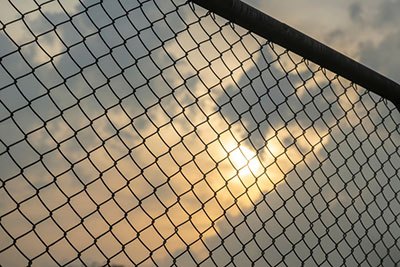Are you looking for an eco-friendly solution to keep your yard or garden secure and safe?
As more homeowners become aware of their impact on the environment, the sustainable chain-link fence has become increasingly popular in recent years as an effective means of providing security without compromising sustainability principles.
In our 2023 guide, we’ll explore how choosing sustainable options can help you create a more environmentally conscious and efficient property – all while helping to protect wildlife too!
Take away key points:
- Chain link fence is made of galvanized steel wire or vinyl-coated steel wire.
- Common applications of the fence include residential and commercial properties, sports fields, pets enclosures, and construction sites.
- Installation methods include digging fence post holes, setting posts with concrete, and stretching wire mesh between gate posts.
- Proper maintenance includes regular cleaning, applying a protective coating, and repairing any damage promptly.
Table of Contents
- What is chain-link fencing?
- Benefits of installing a chain-link fence
- Different applications and uses of chain-link fencing
- FAQs
- How much is 100 ft of chain link fence?
- Is a chain link fence cheaper than wood?
- What are the disadvantages of chain link fence?
- How to convert a chain link fence into a privacy fence?
- Do chain-link fences rust?
- Can chain link fences be reused?
- Do chain link fences need to be grounded?
- How to paint chain link fences?
- Is a top rail necessary for a chain link?
- Final words
What is chain-link fencing?

Chain-link fence is a type of fence made out of woven, interlocking galvanized steel wires that create a diamond-shaped pattern. It is a practical and cost-effective solution for a wide variety of applications.
Chain-link fence method has been used in the past and is a popular choice for many homeowners, businesses, and industries due to its durability, strength, versatility, and customizability.
Chain-link fences come in a range of heights, gauges, and coating options and are available in different colors and styles. Plus, you can also customize gates between posts. They can be used for many purposes, including providing security, creating pet enclosures, and controlling access to certain areas. Chain-link fence is simple to maintain, and either a homeowner or business owner can do it.
Benefits of installing a chain-link fence
1. Durability and strength
Chain-link fencing is made of interlocking galvanized steel wires that provide excellent durability and strength. It can withstand extreme weather conditions, such as heavy rain, wind, and snow, and is resistant to rust and corrosion.
We suggest paying special attention to the materials of the gates between posts, as they are the ones that hold the entire structure of stable.
2. Cost-effective solution
Chain-link fence is one of the most economical fence solutions available. It requires low initial installation costs, as well as low maintenance costs over its lifetime.
The advantages of a chain link fence are especially appreciated by pet owners and farmers, as they can protect dogs and livestock from intruders.
3. Low-maintenance requirements
Chain-link fence is virtually maintenance-free. Unlike other fence options, it does not require regular painting, staining, or sealing. Only occasional cleaning is needed to keep it in good condition.
4. Versatility and customization options

Chain-link fence can be customized to fit any property or application. It comes in various heights, gauges, and coatings and can be installed with different frameworks and terminal options.
There are many easy ways to heighten a chain link fence or to shorten it, and it gives you the option of customization!
5. Security and safety
A chain-link fence provides a high level of security and safety. Its interlocking design makes it difficult to cut or climb, making it an ideal solution for securing properties and assets. It can also be installed with features such as barbed wire or razor ribbon to enhance security.
Different applications and uses of chain-link fencing
1. Residential properties
Chain-link fence is popular among homeowners due to its affordability, durability, and low maintenance requirements. It can be used to secure yards, gardens, and swimming pools and can be customized to fit any residential property.
2. Commercial properties
Chain-link fencing is a cost-effective solution for securing commercial properties, such as warehouses, factories, and parking lots. It can also be used as a security measure for businesses that deal with valuable assets or confidential information.
3. Industrial facilities
Chain-link fence is ideal for securing industrial facilities, such as power plants, construction sites, and oil refineries. Its strength and durability make it an excellent barrier against intruders and can help prevent accidents and injuries.
4. Sports facilities
Chain-link fencing is commonly used in sports facilities such as tennis courts, baseball fields, and soccer fields. Its tall and sturdy design helps keep balls inside the playing area and prevents spectators from interfering with the game.
5. Agriculture and farming
Chain-link fencing is great for farmers and ranchers who need to secure their livestock, crops, or equipment. It can be used for corrals, chicken coops, and storage units and can withstand harsh weather conditions.
Check out our article on the effective ways to stabilize a chain link fence and create an electric fence for maximum protection.
FAQs
How much is 100 ft of chain link fence?
Assuming a mid-range cost of $13 per linear foot, the cost of 100 feet of chain-link fence would be approximately $1,300. However, it is important to note that this is just an estimate and that the actual cost may vary depending on the specific requirements of the project.
Is a chain link fence cheaper than wood?
Yes, chain-link fencing is generally cheaper than wood fencing. The cost of a wood fence can vary depending on factors such as the type of wood, the height, and the size of the property.
On average, a wooden fence costs between $15 and $50 per linear foot, while a chain-link fence costs between $8 and $18 per linear foot.
What are the disadvantages of chain link fence?
Chain-link fencing has some disadvantages, including a lack of privacy, less aesthetic appeal compared to other options, limited color and style options, the potential for rust and corrosion, and recommendations for professional installation.
How to convert a chain link fence into a privacy fence?
There are several ways to convert a chain-link fence into a privacy fence, including installing wooden fence boards, adding privacy slats, installing rolled bamboo fencing, attaching climbing vines or plants, or you can attach outdoor fabric panels.
Do chain-link fences rust?
Yes, chain-link fences are prone to rust over time, especially in areas with high humidity and saltwater exposure. However, proper maintenance, such as cleaning and applying protective coatings, can help prevent rust and extend the fence’s lifespan.
Can chain link fences be reused?
Yes, chain-link fences can be reused. If you are removing a chain-link fence, the posts and rails can be recycled or repurposed for other outdoor projects. The chain link fence fabric can also be reused, depending on the condition of the fence material.
Do chain link fences need to be grounded?

Yes, chain-link fences should be grounded for safety reasons. A chain-link fence can act as a conduit for lightning strikes, which can cause electrical shocks and potentially be fatal. Grounding the fence helps to safely dissipate electrical current into the ground in the event of a lightning strike or electrical fault.
How to paint chain link fences?
To paint a chain-link fence, clean it thoroughly, apply primer, paint it with outdoor paint using a paintbrush or spray gun, and maintain it regularly to prevent rust or damage. The entire process is easy and affordable so you can do it in the comfort of your home.
Is a top rail necessary for a chain link?
Yes, a top rail is necessary for a chain-link fence. It provides structural support and helps to keep the chain-link fence fabric taut and in place. Without a top rail, the chain-link fence fabric may sag, which can compromise the overall integrity of the fence. The top rail should be securely fastened to the fence posts and provide a continuous connection for the fence fabric to attach to the rails.
Final words
We’ve seen how chain-link fencing is an effective, reliable, and cost-effective solution for many different applications.
Whether it’s residential, commercial, or sporting complexes, chain-link fencing is an excellent choice.
So if you’re looking for the perfect fence solution, consider investing in chain link fencing – it may be just what you need!
